Smart Flushing (2020)
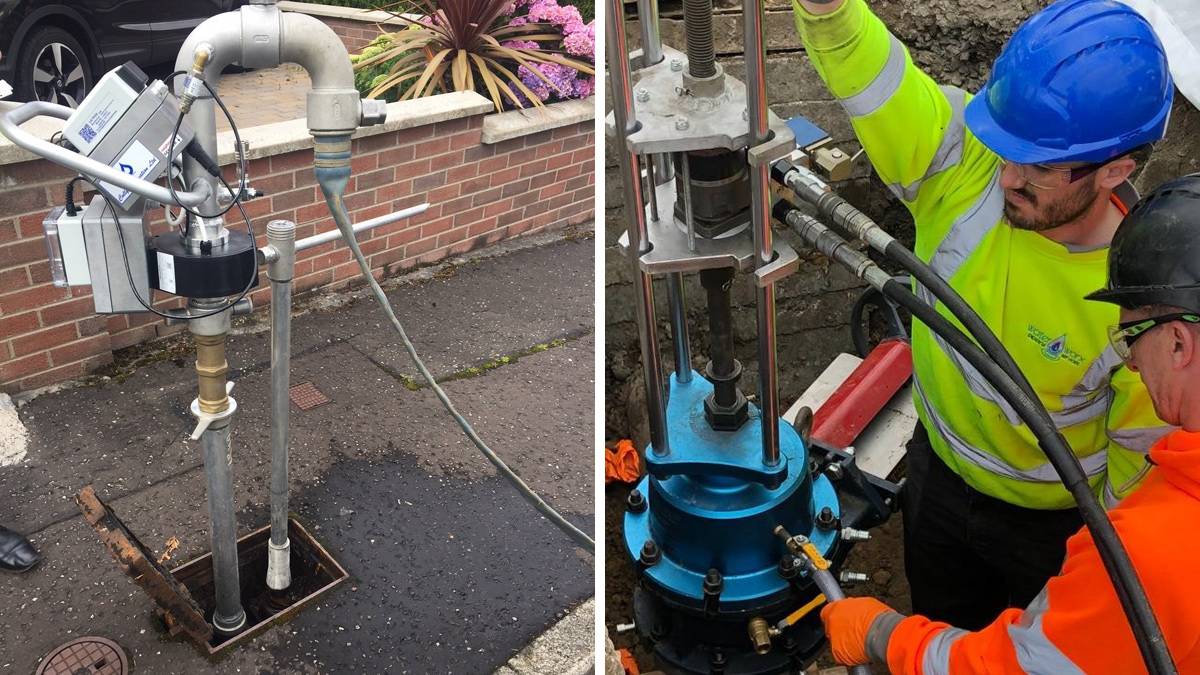
(left) Intelligent standpipe setup and (right) Under-pressure drilling for inline valve installation – Courtesy of NI Water
As with all water companies, Northern Ireland Water (NI Water) work within the targets and guidelines set by their industry regulator, the Northern Ireland Utility Regulator and the Drinking Water Inspectorate (DWI). At present Northern Ireland’s existing potable water main infrastructure comprises approximately 26,700 km of water mains, delivering approximately 560 million litres of clean, safe potable water to approximately 840,000 households and businesses daily. With a large percentage of the existing water distribution infrastructure more than 30 years old and finances predetermined, water main replacement is limited to approximately 0.5% of the existing infrastructure capital expenditure each year. With overarching drivers to deliver an exceptional, world class customer experience and maximise value from NI Water’s investment, a pilot project, involving intelligent unidirectional flushing, was devised to introduce those best value interventions and enable improved customer outcomes.
Background
To improve the reliability, quality and flexibility of the water supply to customers NI Water is committed to an extensive water main rehabilitation project across Northern Ireland, targeting both rural and urban zones. The five-year project, running from 2015-2021, requires the delivery of 814 km of water main upgrades, at an estimated project budget of £120m.
The rehabilitation project targets nominated water mains for upgrade as a result of exhaustive water zone studies. The water zonal studies are focused on strategic parameters within the existing network including structural condition/issues, hydraulic performance, water quality issues and operational improvements/rationalisation. Water main rehabilitation schemes are then prioritised based on the NI Water Watermain Infrastructure Investment Methodology (WIIM). WIIM selects the nominated work schemes and packages for each price control period.
Project identification
As part of NI Water’s rehabilitation project, a pilot unidirectional intelligent flushing project was devised to develop best value interventions and enable improved customer outcomes. The customer interventions considered the applicability of short-term actions versus longer term capital replacement works.
Using data analytics algorithms and GIS to identify customer water quality risk, Northern Ireland’s water zones and district metered areas were ranked for the following:
- Water quality.
- Age of asset.
- Material.
- Historical sampling results.
- Customer contacts.
Following the ranking, ten district metered areas in the Ballygomartin zone of Belfast City were identified for the pilot project, impacting approximately 32,750 customers and 111.5km of water mains.
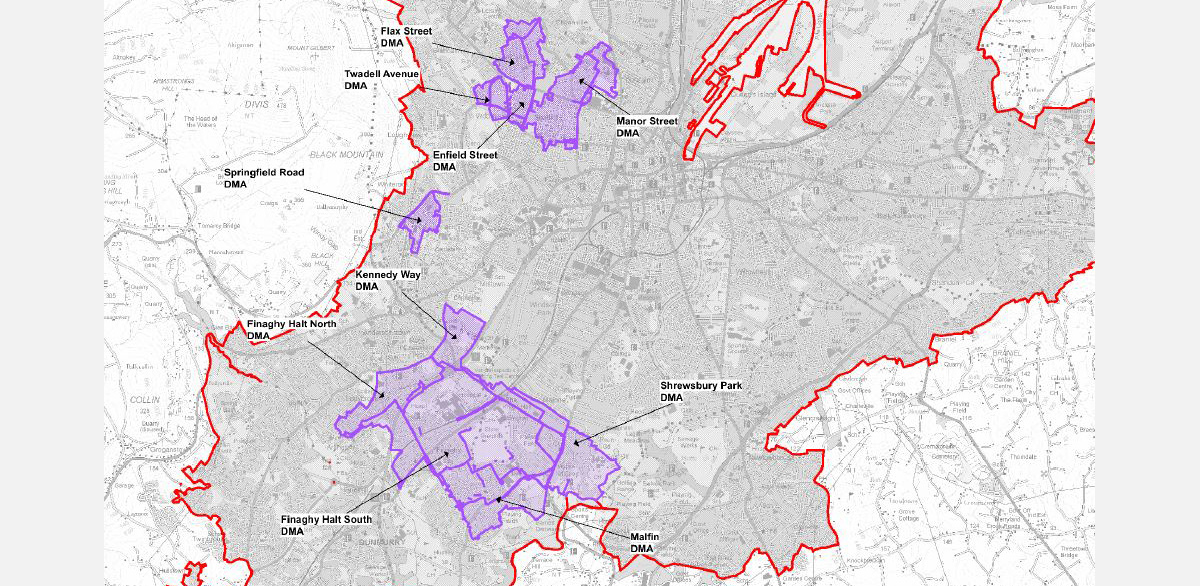
Belfast City water (district) metered areas included in pilot project highlighted in purple – Courtesy of NI Water
Design
As with all water distribution networks, deposits and accumulated sediment build up within the network can lead to discolouration and bacterial and metal concentrations if not eradicated. The accumulated sediment and biofilms also reduce the internal diameter of the mains and can contribute to hydraulic problems and low flow rates.
The use of flushing, the introduction of sufficient force or velocity to shear-off any biofilm or accumulated deposits via opening and closing hydrants, permits the disposal of these unwanted sediments and provides an improvement of the water quality in the network.
Whilst many water companies use conventional flushing to help maintain their networks, intelligent unidirectional flushing affords NI Water the opportunity to optimise its flushing strategy through the collection of data during each flushing event. This data can be analysed in real time or post flushing and provides an in-depth understanding of the surrounding network and water supply risks, the functionality of fittings, aids in the reduction of water usage as a consequence of flushing and informs future capital works investment within the test area.
The key difference between intelligent unidirectional flushing and conventional flushing is that unidirectional flushing flushes water from a clean source through the network, working in one direction only, always bringing the ‘impacted’ water with it. To develop the flushing strategy for the pilot project, hydraulic modelling software was used ensuring that unidirectional flushing was achieved whilst also maintaining customer supply and sufficient water pressure throughout the works.
The modelling also guaranteed that requisite flow velocities and minimum flushing durations were accurately generated. By modelling the network, we helped to minimise the operational requirements, that is, limiting the number of valving and flushing events, whilst still guaranteeing the entire network was positively impacted.
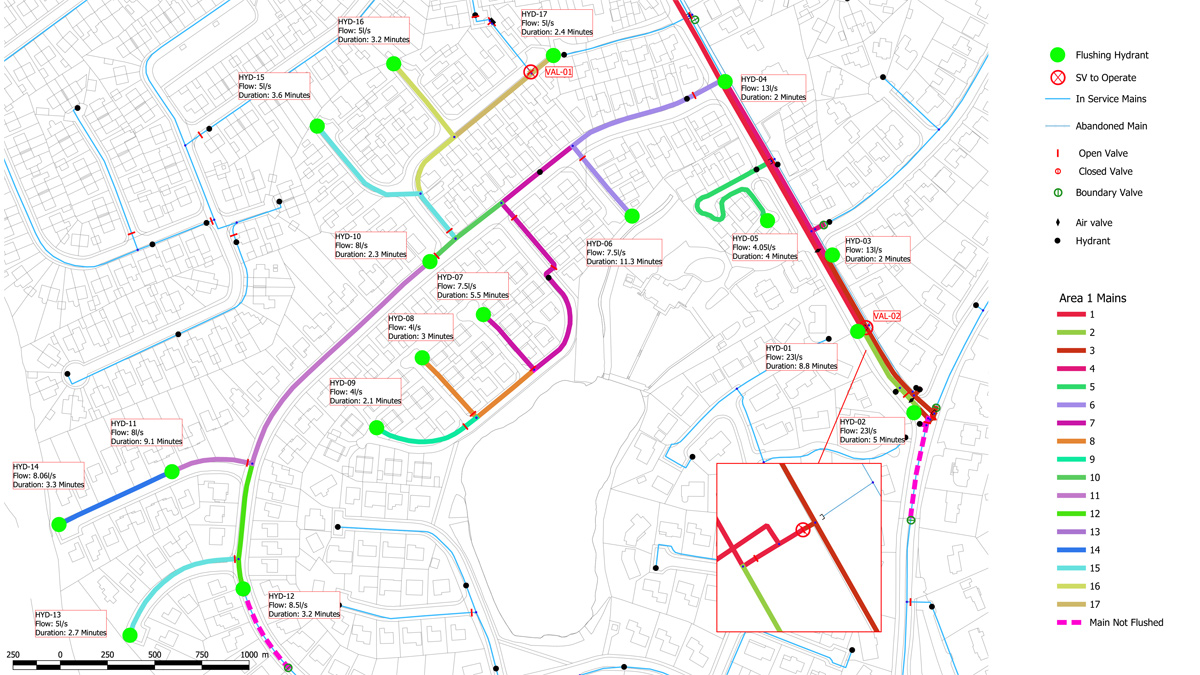
Typical intelligent unidirectional flushing map for area of pilot project denoting hydrant and valve locations, event sequences, minimum flow rates for flushes and minimum durations for flushes – Courtesy of NI Water
NI Water Mains Flushing: Supply chain – key participants
- Project management and delivery: Capita Real Estate & Infrastructure
- Hydraulic modelling and site pack preparation: WSP
- Design advisors: Jacobs
- Main contractor – construction and delivery: BSG Civil Engineering Ltd
- Installation of fittings and flushing works: Waterworx
- Smart equipment for standpipe: Cully Automation Ltd
Enabling and construction works
To enable effective and efficient flushing operations it was important to attain an accurate understanding of the functionality of the fittings (hydrants and valves), for each district metered area.
In each district metered area, the project team completed a fitting functionality walkover, based on pre-existing GIS information. This aided with optimising the hydraulic modelling for each area as the findings highlighted that certain fittings were not located correctly; some fittings had been removed from service and some fittings did not function properly. A list of construction works was then compiled to rectify or return to service any necessary fittings or install new fittings if no prior fitting was in the necessary location.
With world class customer experience at the forefront of every decision, it was decided that all new fitting installations and fitting replacement works would all be conducted using under-pressure or ‘live’ construction techniques. Whilst each fitting installation is slightly more expensive than a conventional equivalent, the decision to use them has resulted in no customer supply interruptions and zero lost minutes per property throughout the pilot study implementation.
During the construction works the first ever water main inline under-pressure valve was installed in Northern Ireland, a massive achievement for the project and NI Water, avoiding an interruption to approximately 2000 properties.
Once the construction works were completed, NI Water’s GIS asset information was updated with the latest as-built information, providing an accurate representation of the infrastructure currently available and providing additional robustness to the network with the new fittings permitting new water rezoning if required.
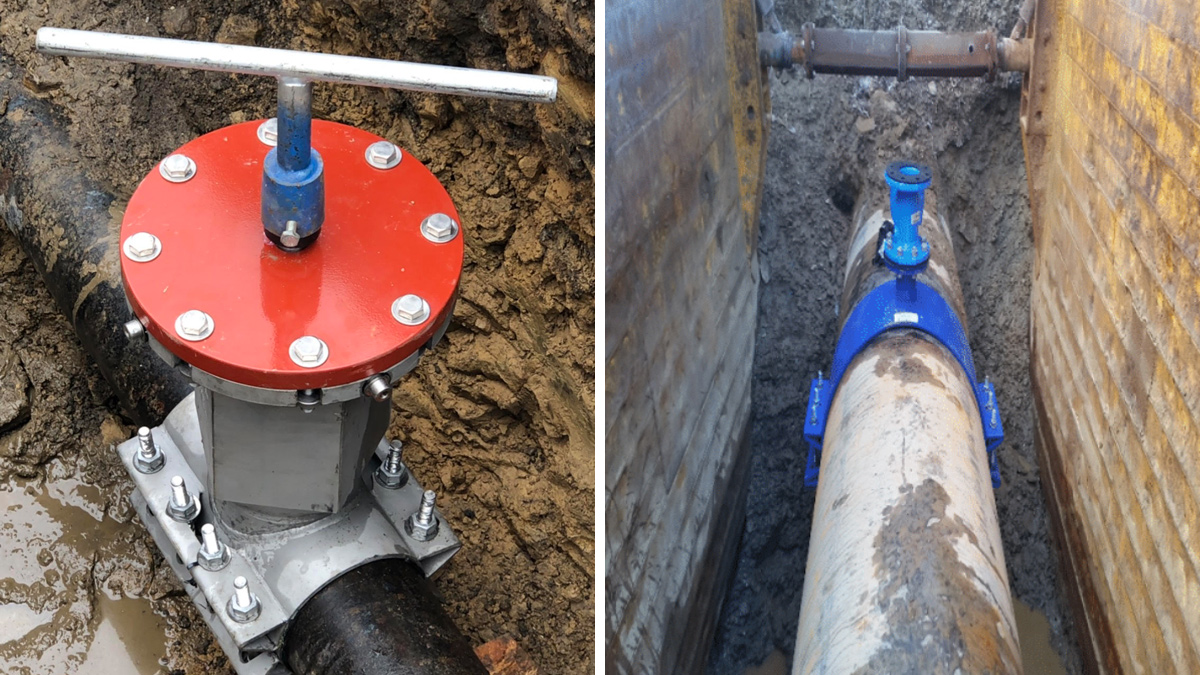
(left) Inline valve installed under-pressure with no customer interruptions and (right) under-pressure drilling of a spun iron water main – Courtesy of NI Water
Intelligent unidirectional flushing works
Unlike conventional flushing, it is not adequate to simply open a hydrant and permit water to be expelled from the system. Conventional flushing utilises uncontrolled flows which have the potential to mobilise sediments and deposits upstream in networks, whilst also potentially depressurising the metered zones and the zones in close proximity.
To enhance the accuracy of the pilot project NI Water invested in an intelligent standpipe from one of their framework suppliers. As well as coming with a wide range of sensors etc. the LCD display panel provided the ability to control the unidirectional flow rates and guarantee that the hydraulic modelling design was adhered too. In addition to displaying the flushing flow rates and flush durations, it recorded the total volume of water used and the GPS coordinates for each flushing event. This information then was transmitted to the supplier’s database and permitted the team to access and download the data live or post flushing operations.
Following each flushing operation, the volume of water used was downloaded from the intelligent standpipe and communicated to the appropriate leakage manager. This afforded the leakage managers the ability to accurately report on what volume of water was used for network cleaning and what was down to leakage. Additionally, through the use of controlled and accurate flow rate knowledge we were able to reduce the volume of water used for network flushing per metered area by approximately 65%, when compared with conventional flushing.
Additionally, the intelligent standpipe was fitted with a turbidity sensor, providing the operators with live turbidity readings during each flushing event. In addition to being critical for post flushing analysis and potentially highlighting sections of main with high deterioration rates, it informed the operators as to when each flush was safe to finish. For example, if the minimum design flush duration was exceeded but the turbidity readings were still deemed excessive flushing would continue until these values came down to acceptable levels.
All flushing operations were conducted at night to minimise disruption to customers, but also due to the reduced demand for water during this period, meaning there was sufficient water supply in the system.
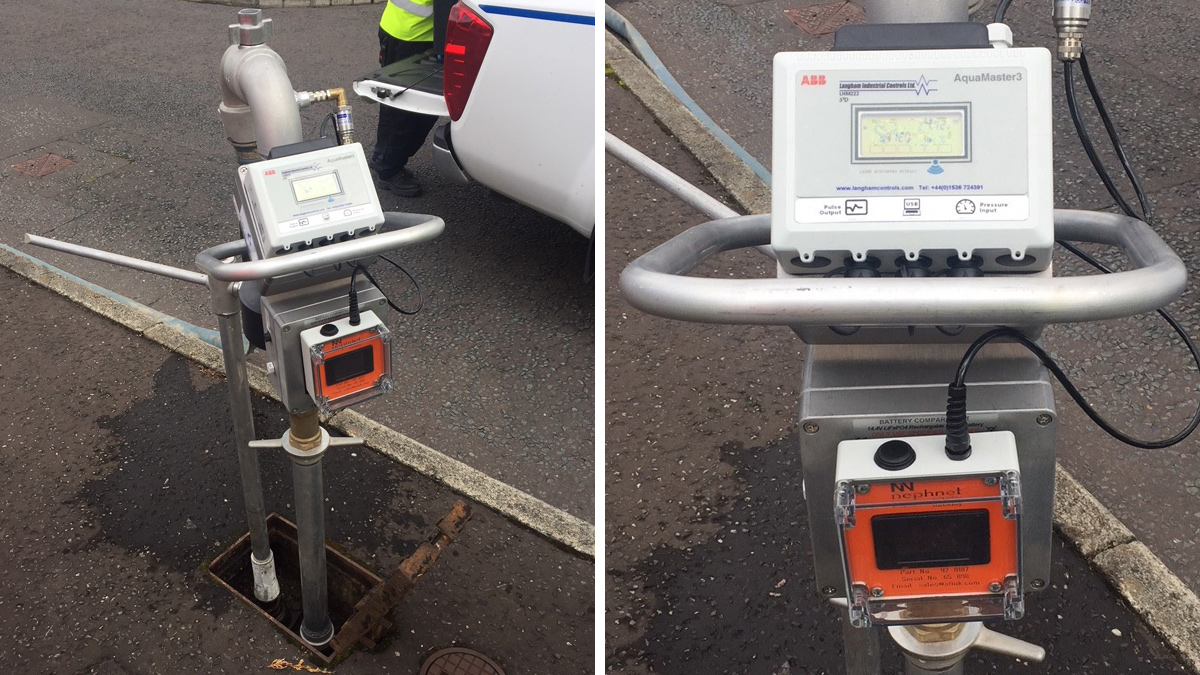
(left) Intelligent standpipe display units and (right) close up of LCD display and turbidity sensor (orange display) below – Courtesy of NI Water
Progress and results to date
At the time of writing (September 2020) all enabling and construction works have been successfully completed interruption free, with 100km of the 111.5km intelligently unidirectionally flushed.
Prior to any flushing works taking place each districted metered area in the pilot scheme was sampled, to provide baseline water quality information for post flushing comparison. The areas that have been sampled post flushing have seen positive results. Firstly, prior to the flushing these areas had an average customer contact rate of 3.1 per 1,000 population, whereas there have been no water quality customer contacts in the subsequent months.
Additionally, there have been marked improvements in samples. The figures below show the percentage reduction in average levels pre and post water sampling as a consequence of unidirectional flushing:
- Iron: -85%
- Manganese: -48%
- Aluminium: -34%
- Turbidity: -89%
Predicted benefits
The works are predicted to reduce NI Water’s customer contacts received for discoloration by 5% per annum, across Northern Ireland during the 12 months following the works. The work is predicted to positively impact upon circa 32,750 customers through a significant improvement in the water quality delivered. The works will deliver improved customer outcomes as measured through reduced customer contacts and reduced risk from discoloration during network events (rezoning or bursts).
Intelligent unidirectional flushing presents the following advantages:
- A significantly lower risk to NI Water’s underground assets due to the use of controlled flow rates and water pressure verification.
- A lower carbon footprint in comparison to traditional rehabilitation as minimal intrusive construction works are required, therefore reducing the equipment required for construction and waste generated when compared with traditional replacement of water mains.
- A reduction in customer disruption as works can be completed without supply interruptions.
- Significantly lower cost when compared to traditional water mains rehabilitation methods (open cut, directional drilling and pipe bursting). Unidirectional flushing is approximately 95% cheaper than traditional rehabilitation and water main replacement techniques.
It should, however, be noted that unidirectional flushing works doesn’t lessen the requirement for water mains replacement and is not an appropriate solution for water mains with structural issues or hydraulic restrictions.
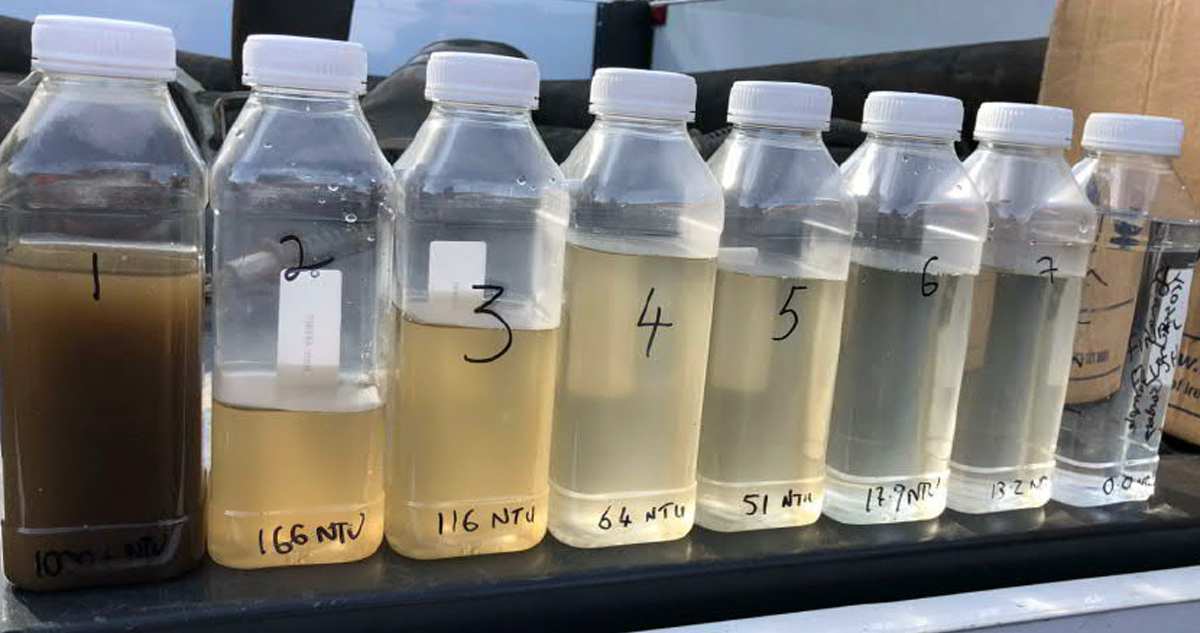
Sample of water taken from standpipe at start of flush to the end of the flush (left to right) – Courtesy of NI Water
Conclusion
To date the success of the pilot project has highlighted the value of intelligent, smart network management in the future. Through the collation and analysis of the data captured, and the use of other technologies available (sensors which report pressure, temperature etc.) high risk water quality zones and deterioration rates can be better understood. This provides the opportunity for effective long-term network management and impactful capital investment, informing future areas for both rehabilitation and unidirectional flushing. All this will help NI Water to achieve maximum value from their investment and provide a world class customer experience.
This initial study project is due for completion in September 2020.



